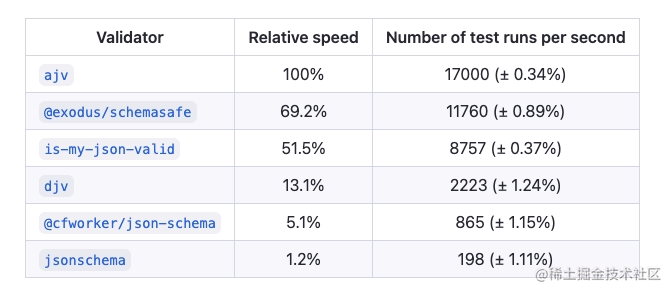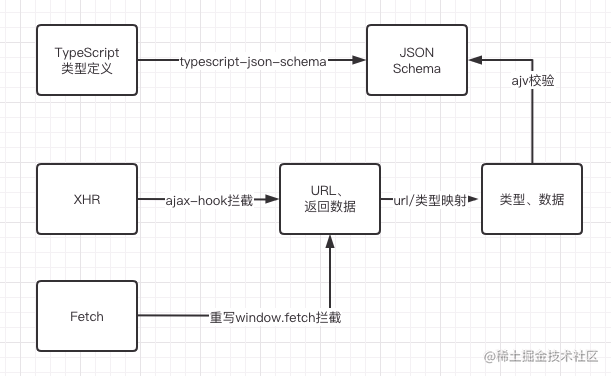如何優雅地校驗後端介面資料,不做前端背鍋俠
背景
最近新接手了一批專案,還沒來得及接新需求,一大堆bug就接踵而至,仔細一看,應該返回陣列的欄位返回了 null,或者沒有返回,甚至返回了字串 "null"???
這我能忍?我立刻截圖發到群裡,用紅框加大加粗重點標出。後端同學也積極響應,答應改正。

第二天,同樣的事情又在其他的專案上演,我只是一個小前端,為什麼什麼錯都找我啊!!
日子不能再這樣下去,於是我決定寫一個工具來解決遇到 bug 永遠在找前端的困境。
TypeScript 執行時校驗
如何對介面資料進行校驗呢,因為我們的專案是 React+TypeScript 寫的,所以第一時間就想到了使用 TypeScript 進行資料校驗。但是眾所周知,TypeScript 用於編譯時校驗,有沒有辦法作用到執行時呢?
我還真找到了一些執行時型別校驗的庫:typescript-needs-types,大部分需要使用指定格式編寫程式碼,相當於對專案進行重構,拿其中 star 最多的 zod 舉例,程式碼如下。
import { z } from "zod";
const User = z.object({
username: z.string(),
});
User.parse({ username: "Ludwig" });
// extract the inferred type
type User = z.infer<typeof User>;
// { username: string }
我寧可查 bug 也不可能重構手裡一大堆專案啊。此種方案 ❎。
此時看到了 typescript-json-schema 可以把 TypeScript 定義轉為 JSON Schema ,然後再使用 JSON Schema 對資料進行校驗就可以啦。這種方案比較靈活,且對程式碼入侵性較小。
搭建一個專案測試一下!
使用 npx create-react-app my-app --template typescript 快速建立一個 React+TS 專案。
首先安裝依賴 npm install typescript-json-schema
建立型別檔案 src/types/user.ts
export interface IUserInfo {
staffId: number
name: string
email: string
}
然後建立 src/types/index.ts 檔案並引入剛才的型別。
import { IUserInfo } from './user';
interface ILabel {
id: number;
name: string;
color: string;
remark?: string;
}
type ILabelArray = ILabel[];
type IUserInfoAlias = IUserInfo;
接下來在 package.json 新增指令碼
"scripts": {
// ...
"json": "typescript-json-schema src/types/index.ts '*' -o src/types/index.json --id=api --required --strictNullChecks"
}
然後執行 npm run json 可以看到新建了一個 src/types/index.json 檔案(此步在已有專案中可能會報錯報錯,可以嘗試在 json 命令中新增 --ignoreErrors 引數),開啟檔案可以看到已經成功轉成了 JSON Schema 格式。
{
"$id": "api",
"$schema": "http://json-schema.org/draft-07/schema#",
"definitions": {
"ILabel": {
"properties": {
"color": {
"type": "string"
},
"id": {
"type": "number"
},
"name": {
"type": "string"
},
"remark": {
"type": "string"
}
},
"required": [
"color",
"id",
"name"
],
"type": "object"
},
"ILabelArray": {
"items": {
"$ref": "api#/definitions/ILabel"
},
"type": "array"
},
"IUserInfoAlias": {
"properties": {
"email": {
"type": "string"
},
"name": {
"type": "string"
},
"staffId": {
"type": "number"
}
},
"required": [
"email",
"name",
"staffId"
],
"type": "object"
}
}
}
使用 JSON Schema 校驗資料
至於如何使用JSON Schema 校驗資料,我找到了現成的庫 ajv,至於為什麼選擇 ajv,主要是因為它說它很快,詳見:https://github.com/ebdrup/json-schema-benchmark/blob/master/README.md

接下來嘗試一下。我找到了中文版檔案,有興趣的可以去看下 http://www.febeacon.com/ajv-docs-zh-cn/。
先安裝依賴 npm install ajv,然後建立檔案 src/validate.ts
import Ajv from 'ajv';
import schema from './types/index.json';
const ajv = new Ajv({ schemas: [schema] });
export function validateDataByType(type: string, data: unknown) {
console.log(`開始校驗,型別:${type}, 資料:`, data);
var validate = ajv.getSchema(`api#/definitions/${type}`);
if (validate) {
const valid = validate(data);
if (!valid) {
console.log('校驗失敗', validate.errors);
}
else {
console.log('校驗成功');
}
}
}
接下來在 src/index.tsx 新增下面程式碼來測試一下。
validateDataByType('IUserInfoAlias', {
email: '[email protected]',
name: 'idonteatcookie',
staffId: 12306
})
validateDataByType('IUserInfoAlias', {
email: '[email protected]',
staffId: 12306
})
validateDataByType('IUserInfoAlias', {
email: '[email protected]',
name: 'idonteatcookie',
staffId: '12306'
})
可以在控制檯看到成功列印如下資訊:

攔截請求
因為專案中傳送請求都是呼叫統一封裝的函數,所以我首先想到的是在函數中增加一層校驗邏輯。但是這樣的話就與專案程式碼耦合嚴重,換一個專案又要再寫一份。我真的有好多專案QAQ。
那乾脆攔截所有請求統一處理好了。
很容易的找到了攔截所有 XMLHttpRequest 請求的庫 ajax-hook,可以非常簡單地對請求做處理。
首先安裝依賴 npm install ajax-hook,然後建立 src/interceptTool.ts:
import { proxy } from 'ajax-hook';
export function intercept() {
// 獲取 XMLHttpRequest 傳送的請求
proxy({
onResponse: (response: any, handler: any) => {
console.log('xhr', response.response)
handler.next(response);
},
});
}
這樣就攔截了所有的 XMLHttpRequest 傳送的請求,但是我突然想到我們的專案,好像使用 fetch 傳送的請求來著???
好叭,那就再攔截一遍 fetch 傳送的請求。
export function intercept() {
// ...
const { fetch: originalFetch } = window;
// 獲取 fetch 傳送的請求
window.fetch = async (...args) => {
const response = await originalFetch(...args);
response.clone().json().then((data: { result: any }) => {
console.log('window.fetch', args, data);
return data;
});
return response;
};
}
為了證明攔截成功,使用 json-server 搭建一個本地 mock 伺服器。首先安裝 npm install json-server,然後在根目錄建立檔案 db.json:
{
"user": { "staffId": 1, "name": "cookie1", "email": "[email protected]" },
"labels": [
{
"id": 1,
"name": "ck",
"color": "red",
"remark": "blabla"
},
{
"id": 2,
"color": "green"
}
]
}
再在 package.json 新增指令碼
"scripts": {
"serve": "json-server --watch db.json -p 8000"
},
現在執行 npm run serve 就可以啟動伺服器了。在 src/index.tsx 增加呼叫介面的程式碼,並引入 src/interceptTool.ts。
import { intercept } from './interceptTool';
// ... other code
intercept();
fetch('http://localhost:8000/user');
const xhr = new XMLHttpRequest();
xhr.open('GET', 'http://localhost:8000/labels');
xhr.send();

可以看到兩種請求都攔截成功了。
校驗介面返回資料
勝利在望,只差最後一步,校驗返回資料。我們校驗資料需要提供兩個關鍵資訊,資料本身和對應的型別名,為了將兩者對應起來,需要再建立一個對映檔案,把 url 和型別名對應起來。
建立檔案 src/urlMapType.ts 然後新增內容
export const urlMapType = {
'http://localhost:8000/user': 'IUserInfoAlias',
'http://localhost:8000/labels': 'ILabelArray',
}
我們在 src/validate.ts 新增函數 validateDataByUrl
import { urlMapType } from './urlMapType';
// ...
export function validateDataByUrl(url: string, data: unknown) {
const type = urlMapType[url as keyof typeof urlMapType];
if (!type) {
// 沒有定義對應格式不進行校驗
return;
}
console.log(`==== 開始校驗 === url ${url}`);
validateDataByType(type, data);
}
然後在 src/interceptTool.ts 檔案中參照
import { proxy } from 'ajax-hook';
import { validateDataByUrl } from './validate';
export function intercept() {
// 獲取 XMLHttpRequest 傳送的請求
proxy({
onResponse: (response, handler: any) => {
validateDataByUrl(response.config.url, JSON.parse(response.response));
handler.next(response);
},
});
const { fetch: originalFetch } = window;
// 獲取 fetch 傳送的請求
window.fetch = async (...args) => {
const response = await originalFetch(...args);
response.json().then((data: any) => {
validateDataByUrl(args[0] as string, data);
return data;
});
return response;
};
}
現在可以在控制檯看到介面資料校驗的介面辣~ ✿✿ヽ(°▽°)ノ✿

總結下流程圖

後續規劃
目前所做的事情,準確的說不是攔截,只是獲取返回資料,然後對比列印校驗結果,因為初步目標不涉及資料的處理。
後續會考慮對不合法的資料進行處理,比如應該返回陣列但是返回了 null 的情況,如果能自動賦值 [],就可以防止前端頁面崩潰的情況了。
參考資料
- TypeScript 執行時型別檢查指南
- 掌握甩鍋技術: Typescript 執行時資料校驗
- Intercepting JavaScript Fetch API requests and responses